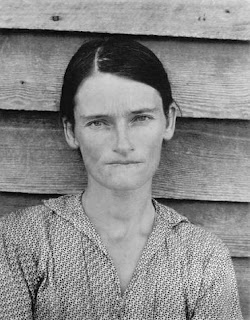

Upon entering the Foster Gallery, I didn’t know much about either Walker Evans or Baldwin Lee other than the few things we learned in class. I can’t say that I’m any kind of artist but I do know how to appreciate art. At first glance, Evans does seem like a documentary photographer but once you take the time to truly look at his photographs, you learn so much more about him as a person and as a photographer. He wasn’t just touching the surface of what was there; he was diving into the deep end and exposing what the average person doesn’t see. For example, in the picture of the Burrough’s bed. At first glance all you see is a bed and you think nothing more of it. But if you look again, you see the stains and flies that lay across it suggesting that they don’t live in the best of conditions. Along with the photo of their silverware, that is missing forks and has continuously been moved higher out of the reach of children. After hearing Lee talk about why and what Evans saw, I had a new appreciation for his photography and found myself wanting Lee to talk more about what Evans was really trying to portray. I think Evans photographed during the perfect era because he really captured what was going on and compared the “rich” to the poor. He didn’t just portray the conditions they were living in, but showed the emotions they were actually feeling. He captured the secrets of the houses these people lived in. Another thing I found interesting about Evans is the way he manipulated the two different pictures of Allie Mae Burroughs. Where one photo she looked more open, at peace with everything around her; whereas the other, she looks closed, almost depressed.
Baldwin Lee on the other hand, seems to have a different outtake on photography. I was looking at his photographs of the World Trade Center before 9/11. I came across a photo where the Towers are in the background and the angle is from a rundown street view. I find this picture appealing because even though the Towers are glorious, there’s another side of town too. That even people from the “bad” side of town get to look upon this great wonder. While looking at Lee’s work, I can across his comparative study between blacks and whites. He took pictures of both and combined them into one photo. One particularly caught by eye though. It was of black and white men, both probably in their twenties. The black man has dark eyes, acne and seems like a hard spirit. The white man on the other side seems to be pampered and has light in his eyes. This photo makes me think that the white man is suppose to be portrayed as superior. Lee has a very unique way of combining photos with each other. Just like his panoramic views of various New York scenes and other landscapes. He has tremendous talent for making you see one thing but after seconds, seeing many more. In some of the New York scenes it almost seemed like it came around in a complete circle. My favorite one started out with a woman standing on an overpass and it slowly moved through the fencing and walls back to where the woman was standing, but she wasn’t there anymore. I was very impressed with Lee’s talk the other day, I found him very informational and inspirational. And now after looking over his photo’s I think that even more so.Brooke Leanna




No comments:
Post a Comment